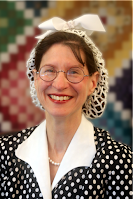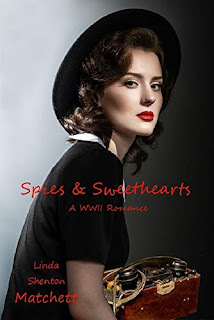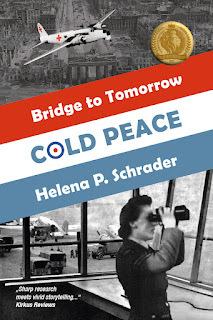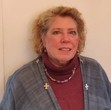Why I Write Historical Fiction - A Guest Blogpost by Linda Matchett
Linda Shenton Matchett writes happily-ever-afterhistorical Christian fiction about second chances and women who overcome life’schallenges to be better versions of themselves. Follow the journeys ofrelatable characters whose faith is sorely tested, yet in the end, emerge triumphant.Be encouraged in your own faith-walk through stories of history and hope. Anative of Baltimore, Maryland, Linda was born a stone’s throw from Fort McHenry(of Star-Spangled Banner fame) and has lived in historical places all her life.She now lives in central New Hampshire where she is a volunteer docent andarchivist at the Wright Museum of WWII.

This opportunity toshare about why I write historical fiction has come an interesting time becauseI recently spent three months with a branding consultant. Her first fewquestions were about this very topic. Why did I write? Why did I write fiction?And…why did I write historical fiction?
When I was in thirdgrade, my parents gifted me a notebook, and I’ve been scribbling stories eversince. Thanks to my dad’s job, we moved often, mostly to areas steeped inhistory. Writing was my one constant. However, after entering the workforce, myfiction writing dropped away as I focused on business writing for my job. Aftermoving to New Hampshire, I freelanced for travel and live style magazines, andas much as I enjoyed that, fiction was always my first love.
But what to write about? I startedlots of stories, but struggled to finish. All historical, they covered avariety of eras, but none of the plotlines resonated with me.
Then one afternoon at the WrightMuseum of WWII changed my life...
The carpet muffled my footsteps as Iwandered into the home front gallery during my volunteer docent shift. Isauntered past the dioramas: a five-and-dime, a kitchen, then a living room,chatting with visitors and answering questions. As I approached the exhibitabout war correspondents, my eye was drawn to the small photo at the bottom: awoman wearing a combat helmet and a cheeky grin as she cradled her camera,finger poised over the button. Riveted, I stopped.
Who was she, this lone women in adisplay of men? I scanned the placard: Therésé Bonney, photojournalist.Minimal information so I yanked out my smart phone and keyed in her name. Factsand figures emerged, but one struck me more than the others: Of the more thantwo thousand accredited war correspondents, only 127 were women, including Ms.Bonney. Intrigued, I continued to dig. My pulse raced as I read.
By all accounts, she and the otherfemale correspondents had it tough, often relegated to fluff pieces and deniedaccess to combat zones. They fought for the right to tell stories…realstories…the same sort of stories the men had access to. By hook and by crook,these stalwart women made their way across Europe and other countries, shiningthe light on war’s atrocities.
There had to me more women like them.Women who went outside their comfort zone to do jobs never before held by womenin places they’d never dared go: pilots, welders, mechanics, doctors, farmers,truck and ambulance drivers, parachute riggers, radio operators, laboratorytechnicians, and even spies. Then there were the women who served in everybranch of the armed forces. Some of the women remained on the U.S. home frontwhile others crossed the globe to places most people had never heard of.
Inspired by the tenacity anddoggedness of these often-overlooked women to follow a story wherever it led, Iknew I needed to shine the light on their stories, their lives, andthose of other ordinary women who did extraordinary things – things I couldnever do in my wildest dreams.

Spies & Sweethearts
Shewants to do her part. He’s just trying to stay out of the stockade. Will twoagents deep behind enemy lines find capture… or love?
1942.Emily Strealer is tired of being told what she can’t do. Wanting to proveherself to her older sisters and do her part for the war effort, the highschool French teacher joins the OSS and trains to become a covert operative. Afterher training, she finds herself parachuting into occupied France with herinstructor to send radio signals to the Resistance.
MajorGerard Lucas has always been a rogue. Transferring to the so-called “Office ofDirty Tricks” to escape a court-martial, he poses as a husband to one of histrainees on a dangerous secret mission. But when their cover is blown afteronly three weeks, he has to flee with the young schoolteacher to avoid Naziarrest.
Runningfor their lives, Emily clings to her mentor’s military experience during theharrowing three-hundred-mile trek to neutral Switzerland. And while Gerardcan’t bear the thought of his partner falling into German hands, their forgedpapers might not be enough to get them over the border.
Website/Blog:http://www.LindaShentonMatchett.com
Blog Host Helena P. Schrader is the author of 25 historical fiction and non-fiction books, eleven of which have one one or more awards. You can find out more about her, her books and her awards at: https://helenapschrader.com
Her most recent release, Cold Peace, was runner-up for the Historical Fiction Company BOOK OF THE YEAR 2023 Award, as well as winning awards from Maincrest Media and Readers' Favorites. Find out more at: https://www.helenapschrader.com/cold-peace.html




